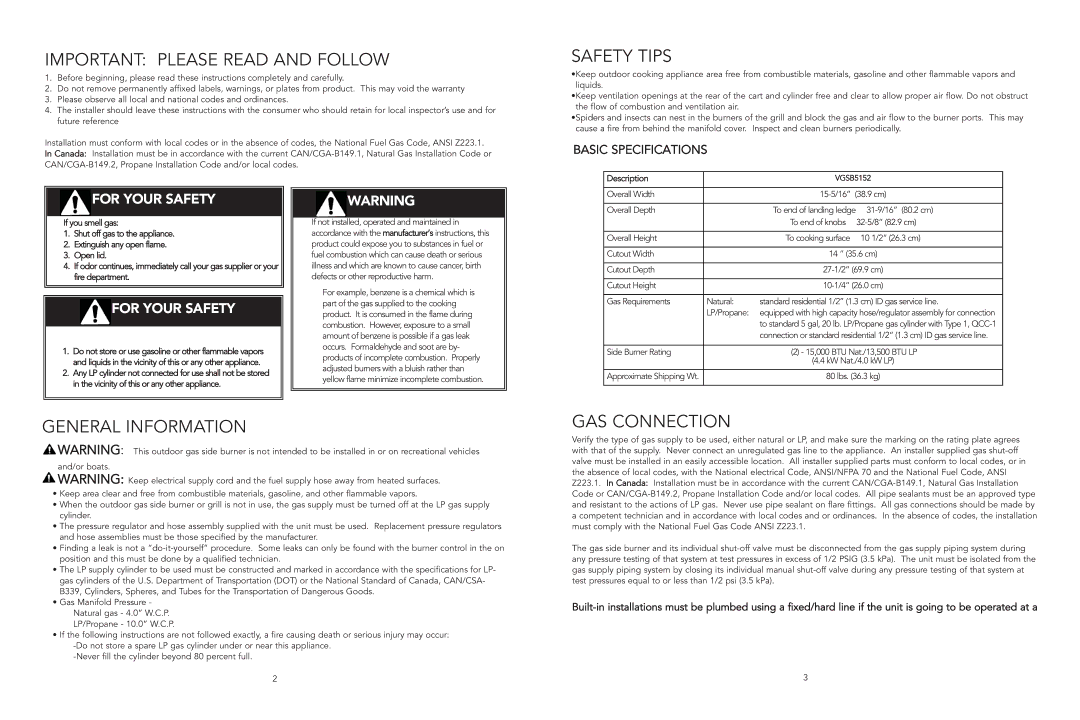
IMPORTANT: PLEASE READ AND FOLLOW
1.Before beginning, please read these instructions completely and carefully.
2.Do not remove permanently affixed labels, warnings, or plates from product. This may void the warranty
3.Please observe all local and national codes and ordinances.
4.The installer should leave these instructions with the consumer who should retain for local inspector’s use and for future reference
Installation must conform with local codes or in the absence of codes, the National Fuel Gas Code, ANSI Z223.1. In Canada: Installation must be in accordance with the current
SAFETY TIPS
•Keep outdoor cooking appliance area free from combustible materials, gasoline and other flammable vapors and liquids.
•Keep ventilation openings at the rear of the cart and cylinder free and clear to allow proper air flow. Do not obstruct the flow of combustion and ventilation air.
•Spiders and insects can nest in the burners of the grill and block the gas and air flow to the burner ports. This may cause a fire from behind the manifold cover. Inspect and clean burners periodically.
BASIC SPECIFICATIONS
 FOR YOUR SAFETY
FOR YOUR SAFETY
If you smell gas:
1.Shut off gas to the appliance.
2.Extinguish any open flame.
3.Open lid.
4.If odor continues, immediately call your gas supplier or your fire department.
![]() FOR YOUR SAFETY
FOR YOUR SAFETY
1.Do not store or use gasoline or other flammable vapors and liquids in the vicinity of this or any other appliance.
2.Any LP cylinder not connected for use shall not be stored in the vicinity of this or any other appliance.
![]() WARNING
WARNING
If not installed, operated and maintained in accordance with the manufacturer’s instructions, this product could expose you to substances in fuel or fuel combustion which can cause death or serious illness and which are known to cause cancer, birth defects or other reproductive harm.
For example, benzene is a chemical which is part of the gas supplied to the cooking product. It is consumed in the flame during combustion. However, exposure to a small amount of benzene is possible if a gas leak occurs. Formaldehyde and soot are by- products of incomplete combustion. Properly adjusted burners with a bluish rather than yellow flame minimize incomplete combustion.
Description |
| VGSB5152 | |
|
|
| |
Overall Width |
| ||
|
|
|
|
Overall Depth |
| To end of landing ledge | |
|
| To end of knobs | |
|
|
|
|
Overall Height |
| To cooking surface | 10 1/2” (26.3 cm) |
|
|
| |
Cutout Width |
| 14 ” (35.6 cm) | |
|
|
| |
Cutout Depth |
| ||
|
|
| |
Cutout Height |
| ||
|
|
| |
Gas Requirements | Natural: | standard residential 1/2” (1.3 cm) ID gas service line. | |
| LP/Propane: | equipped with high capacity hose/regulator assembly for connection | |
|
| to standard 5 gal, 20 lb. LP/Propane gas cylinder with Type 1, | |
|
| connection or standard residential 1/2” (1.3 cm) ID gas service line. | |
|
|
| |
Side Burner Rating |
| (2) - 15,000 BTU Nat./13,500 BTU LP | |
|
| (4.4 kW Nat./4.0 kW LP) | |
|
|
| |
Approximate Shipping Wt. |
| 80 lbs. (36.3 kg) | |
|
|
|
|
GENERAL INFORMATION
![]() WARNING: This outdoor gas side burner is not intended to be installed in or on recreational vehicles
WARNING: This outdoor gas side burner is not intended to be installed in or on recreational vehicles
and/or boats.
![]() WARNING: Keep electrical supply cord and the fuel supply hose away from heated surfaces.
WARNING: Keep electrical supply cord and the fuel supply hose away from heated surfaces.
•Keep area clear and free from combustible materials, gasoline, and other flammable vapors.
•When the outdoor gas side burner or grill is not in use, the gas supply must be turned off at the LP gas supply cylinder.
•The pressure regulator and hose assembly supplied with the unit must be used. Replacement pressure regulators and hose assemblies must be those specified by the manufacturer.
•Finding a leak is not a
•The LP supply cylinder to be used must be constructed and marked in accordance with the specifications for LP- gas cylinders of the U.S. Department of Transportation (DOT) or the National Standard of Canada, CAN/CSA- B339, Cylinders, Spheres, and Tubes for the Transportation of Dangerous Goods.
•Gas Manifold Pressure -
Natural gas - 4.0” W.C.P.
LP/Propane - 10.0” W.C.P.
•If the following instructions are not followed exactly, a fire causing death or serious injury may occur:
2
GAS CONNECTION
Verify the type of gas supply to be used, either natural or LP, and make sure the marking on the rating plate agrees with that of the supply. Never connect an unregulated gas line to the appliance. An installer supplied gas
The gas side burner and its individual
3
